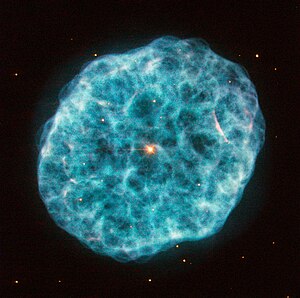

| Emission nebula | |
|---|---|
| Planetary nebula | |

As seen from the Hubble Space Telescope
| |
| Observation data: J2000 epoch | |
| Right ascension | 04h06m 59.39s[1] |
| Declination | +60° 55′ 14.4″[1] |
| Distance | est. 4,240 ly (1.30 kpc)[2] ly |
| Apparent magnitude (V) | 13.0[1] |
| Apparent dimensions (V) | 0.863' (diameter) |
| Constellation | Camelopardalis |
| Physical characteristics | |
| Radius | 0.5 ly |
| Designations | PK 144+6.1, PN G 144.5+06.5, GC 801, CS 14.4, H 4.53 |
| See also: Lists of nebulae | |
NGC 1501 (also known as the Camel's Eye Nebula[3] or the Oyster Nebula[4]) is a complex planetary nebula located in the constellationofCamelopardalis, it was discovered on 27 August 1787 by William Herschel.[2][5]
The central star of the planetary nebula has a spectral type of [WC4], similar to that of a carbon-rich Wolf–Rayet star.[6] It is a pulsating star, meaning that its brightness varies regularly and periodically. In the case of NGC 1501's progenitor star, this is incredibly fast, with the star's brightness changing significantly in just half an hour. An analysis of Gaia data suggests that the central star is a binary system.[7] Visible-light observations capture the glow of gases including hydrogen and nitrogen.[8] The total mass of the nebula is estimated to be around 0.22 M☉, most of which is ionized gas (0.21 M☉) and a small fraction (8.9×10−4 M☉) is carbon-rich dust.[9]
|
| |||||||||||||
|---|---|---|---|---|---|---|---|---|---|---|---|---|---|
| |||||||||||||
| Stars |
| ||||||||||||
| |||||||||||||
| |||||||||||||
| |||||||||||||
| Galaxies |
| ||||||||||||
| |||||||||||||
| |||||||||||||
This nebula-related article is a stub. You can help Wikipedia by expanding it. |